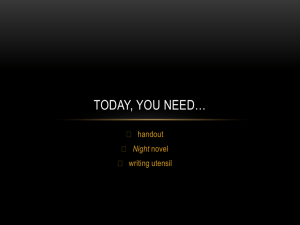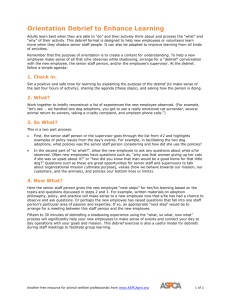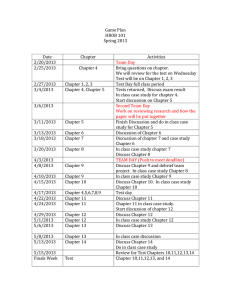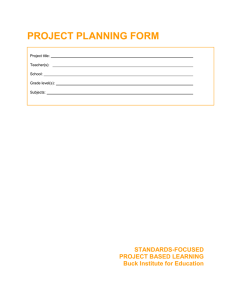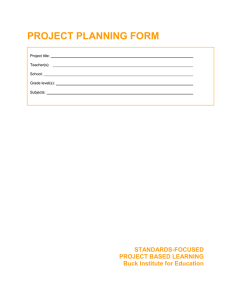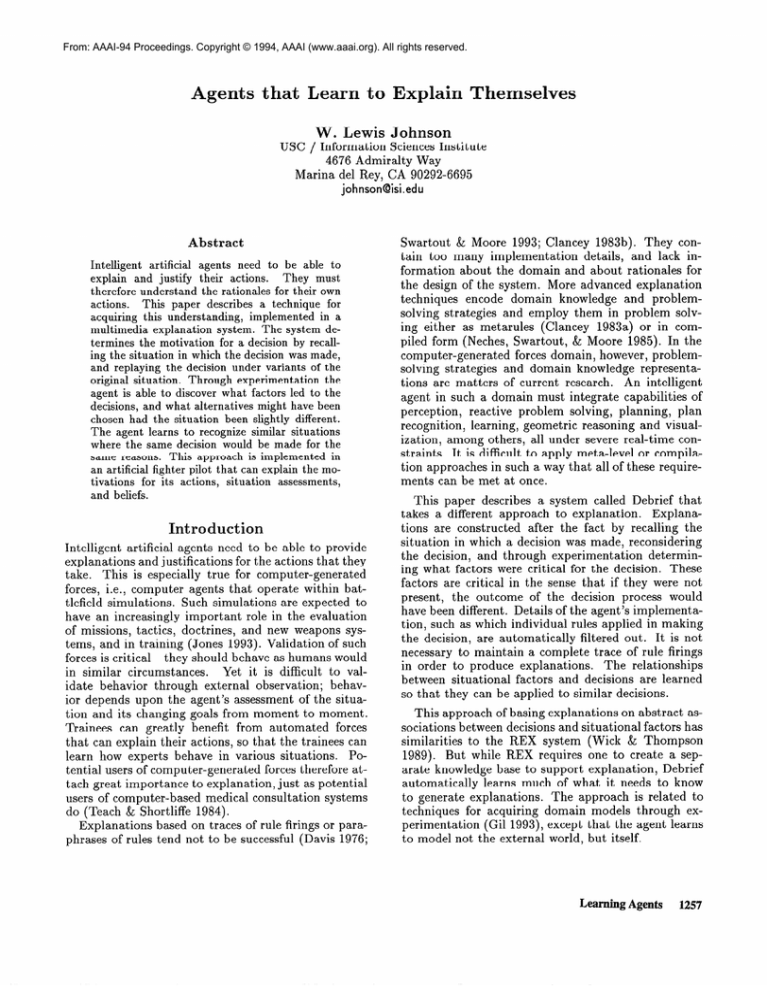
From: AAAI-94 Proceedings. Copyright © 1994, AAAI (www.aaai.org). All rights reserved.
Agents that Learn to Explain Themselves
W.
Lewis Johnson
USC / Information Sciences Institute
4676 Admiralty Way
Marina de1 Rey, CA 90292-6695
johnson@isi.edu
Abstract
Intelligent
artificial
agents need to be able to
explain and justify their actions.
They must
therefore understand
the rationales for their own
actions.
This paper describes
a technique
for
acquiring this understanding,
implemented
in a
multimedia
explanation
system.
The system determines the motivation
for a decision by recalling the situation in which the decision was made,
and replaying the decision under variants of the
original situation.
Through experimentation
the
agent is able to discover what factors led to the
decisions, and what alternatives
might have been
chosen had the situation
been slightly different.
The agent learns to recognize similar situations
where the same decision would be made for the
same reasons.
This approach is implemented
in
an artificial fighter pilot that can explain the motivations
for its actions,
situation
assessments,
and beliefs.
Introduction
Intelligent artificial agents need to be able to provide
explanations and justifications for the actions that they
take. This is especially true for computer-generated
forces, i.e., computer agents that operate within battlefield simulations.
Such simulations are expected to
have an increasingly important role in the evaluation
of missions, tactics, doctrines, and new weapons systems, and in training (Jones 1993). Validation of such
forces is critical-they
should behave as humans would
Yet it is difficult to valin similar circumstances.
idate behavior through external observation;
behavior depends upon the agent’s assessment of the situation and its changing goals from moment to moment.
Trainees can greatly benefit from automated
forces
that can explain their actions, so that the trainees can
learn how experts behave in various situations.
Potential users of computer-generated
forces therefore attach great importance to explanation, just as potential
users of computer-based
medical consultation systems
do (Teach & Shortliffe 1984).
Explanations based on traces of rule firings or paraphrases of rules tend not to be successful (Davis 1976;
Swartout & Moore 1993; Clancey 198313). They contain too many implementation
details, and lack information about the domain and about rationales for
the design of the system. More advanced explanation
techniques encode domain knowledge and problemsolving strategies and employ them in problem solving either as metarules (Clancey 1983a) or in compiled form (Neches, Swartout, & Moore 1985). In the
computer-generated
forces domain, however, problemsolving strategies and domain knowledge representations are matters of current research.
An intelligent
agent in such a domain must integrate capabilities of
perception,
reactive problem solving, planning, plan
recognition, learning, geometric reasoning and visualization, among others, all under severe real-time constraints. It is difficult to apply meta-level or compilation approaches in such a way that all of these requirements can be met at once.
This paper describes a system called Debrief that
takes a different approach to explanation.
Explanations are constructed
after the fact by recalling the
situation in which a decision was made, reconsidering
the decision, and through experimentation
determining what factors were critical for the decision. These
factors are critical in the sense that if they were not
present, the outcome of the decision process would
have been different. Details of the agent’s implementation, such as which individual rules applied in making
the decision, are automatically
filtered out. It is not
necessary to maintain a complete trace of rule firings
in order to produce explanations.
The relationships
between situational factors and decisions are learned
so that they can be applied to similar decisions.
This approach of basing explanations on abstract associations between decisions and situational factors has
similarities to the REX system (Wick & Thompson
1989). But while REX requires one to create a separate knowledge base to support explanation,
Debrief
automatically
learns much of what it needs to know
to generate explanations.
The approach is related to
techniques for acquiring domain models through experimentation (Gil 1993), except that the agent learns
to model not the external world, but itself.
Learning Agents
1257
Help1
Control Question
Control Question
My current lateral separation was too high
The desired lateral separation was not achieved.
t selected a missile.
f started the maneuver to get into the missile’s LAR.
1cut to increase lateral separation and target aspect.
The desired target aspect was achieved.
1performed a maintain-ta.
1finished the maneuver to get into the missile’s LAR.
The aim-54’s launch acceptability region was achieved.
Figure 1: Part of a an event summary
Debrief is implemented
as part of the TacAir-Soar
fighter pilot simulation (Jones et al. 1993). Debrief
can describe and justify decisions using a combination
of natural language and diagrams.
It is written in a
domain-independent
fashion so that it can be readily incorporated
into other intelligent systems,
Current plans call for incorporating
it into the REACT
system, an intelligent assistant for operators of NASA
Deep Space Network ground tracking stations (Hill &
Johnson 1994).
An Example
Consider the following scenario. A fighter is assigned
a Combat Air Patrol (CAP) mission, i.e., it should fly
a loop pattern, scanning for enemy aircraft.
During
the mission a bogey (an unknown aircraft) is spotted
on the radar.
The E2C, an aircraft whose purpose
is to scan the airspace and provide information to the
fighters, confirms that the bogey is hostile. The fighter
closes in on the bogey, fires a missile which destroys the
bogey, and then resumes its patrol.
After each mission it is customary to debrief the pilot.
The pilot is asked to describe the engagement
from his perspective, and explain key decisions along
the way. The pilot must justify his assessments of the
situation, e.g., why the bogey was considered a threat.
TacAir-Soar is able to simulate pilots executing missions such as this, and Debrief is able to answer questions about them. TacAir-Soar
controls a simulation
environment called ModSAF (Calder et al. 1993) that
simulates the behavior of military platforms. TacAirSoar receives information from ModSAF about aircraft
status and radar information, and issues commands to
fly the simulated aircraft and employ weapons. After
an engagement users can interact with Debrief to ask
questions about the engagement.
The following is a typical interaction with Debrief.
1258
Robotics
Figure 2: Explanations
of the agent’s decisions
Questions are entered through a window interface, by
selecting a type of question and pointing to the event or
assertion that the question refers to. The first question
selected is of type Describe-Event,
i.e., describe some
event that took place during the engagement; the event
chosen is the entire mission. Debrief then generates a
summary of what took place during the mission. The
user is free to select statements in the summary and
ask follow-on questions about them.
Figure 1 shows part of a typical mission summary.
One of the statements in the summary, “I started using
my weapons ,” has been selected by the user, so that
a follow-on question may be asked about it. Figure 2
shows the display at a later point in the dialog, after
follow-on questions have been asked.
First, a question of type Explain-Action
was asked of the decision
to employ weapons, i.e., explain why the agent chose
to perform this action. The explanation appears in the
figure, beginning with the sentence “I started using my
weapons because the intercept geometry was selected
and...” Debrief also lists an action that it did not take,
but might have taken under slightly different circumstances: flying toward the bogey to decrease distance.
One can see that the agent’s actions are motivated
largely by previous assessments and decisions.
The
bottom of Figure 2 shows the answer to a follow-on
question relating to one of those assessments, namely
“ROE was achieved ,” 1 Debrief lists the following fac‘ROE stands for Rules of Engagement,
tions under which the fighter is authorized
enemy.
i.e., the condito engage the
tors:
the bogey was known to be hostile (i.e., a
“bandit”),
the bogey was identified through electronic
means and confirmation
of the identification
was obtained from the E2C.
In order to answer such questions, Debrief does the
following.
First, it recalls the events in question and
the situations in which the events took place. When
summarizing
events, it selects information about the
intermediate states and subevents that should be presented, selects appropriate media for presentation of
this information
(the graphical display and/or natural language),
and then generates the presentations.
To determine what factors in the situation led to the
action or conclusion, Debrief invokes the TacAir-Soar
problem solver in the recalled situation, and observes
what actions the problem solver takes. The situation
is then repeatedly and systematically
modified, and
the effects on the problem solver’s decisions are observed. Beliefs are explained by recalling the situation
in which the beliefs arose, determining what decisions
caused the beliefs to be asserted, and determining what
factors were responsible for the decisions.
Implementation
Concerns
Debrief is implemented in Soar, a problem-solving
architecture that implements a theory of human cognition(Newel1 1990). Problems in Soar are represented
as goals, and are solved within problem spaces. Each
problem space consists of a state, represented as a set
of attribute-value pairs, and a set of operators. All processing in Soar, including applying operators, proposstates, is pering problem spaces, and constructing
During problem solving Soar
formed by productions.
repeatedly selects and applies operators to the state.
When Soar is unable to make progress, it creates a new
subgoal and problem space to determine how to proceed. Results from these subspaces are saved by Soar’s
chunking mechanism as new productions, which can be
applied to similar situations.
The explanation techniques employed in Debrief are
not Soar-specific;
however, they do take advantage of
certain features of Soar.
e The explicit problem space representation
enables
Debrief to monitor problem solving when constructing explanations.
o Since Soar applications are implemented in production rules, it is fairly straightforward
to add new
rules for explanation-related
processing.
o Learning enables Debrief to reuse the results of previous explanation
processing, and build up knowledge about the application domain.
The current implementation
of Debrief consists of
thirteen Soar problem spaces. Two are responsible for
inputing questions from the user, three recall events
and states from memory, four determine the motivations for actions and beliefs, three generate presentations, and one provides top-level control. The follow-
ing sections describe the system components
involved
in determining motivations for decisions and beliefs;
other parts of the system are described in (Johnson
1994).
Memory
and Recall
In order for Debrief to describe and explain decisions,
it must be able to recall the decisions and the situations in which they occurred. In order words, the agent
requires an episodic memory. Debrief includes productions and operators that execute during the problem
solving process in order to record episodic information,
and a problem space called Recall-State
that reconstructs states using this episodic information.
The choice of what episodic information
to record
is determined by a specification of the agent’s working
memory state. This specification
identifies the state
attributes that are relevant for explanation,
and identifies their properties, e.g., their cardinality and signature, and how the attribute values may change during
problem solving. In order to apply Debrief to a new
problem solver, it is necessary to supply such a specification for the contents of the problem solver’s working
memory, and indicate which operators implement decisions what should be explainable.
However, it is not
necessary to specify how the problem solver uses its
working memory in making decisions-that
is determined by Debrief automatically.
When the problem solver applies an operator that
as marked as explainable, Debrief records the operator
application in a list of events that took place during
the problem solving. It also records all attribute values
that have changed since the last problem solving event
that was recorded.
Debrief then builds chunks that associate the state
changes with the problem solving event. Once these
chunks are built, the state changes can be deleted from
working memory, because the chunks are sufficient to
enable Debrief to recall the working memory state.
During explanation,
when Debrief needs to recall the
state in which a problem solving event occurred,
it
This space
invokes the Recall-State
problem space.
reconstructs the state by proposing possible attribute
values; the chunks built previously fire, selecting the
value that was associated with the event. Recall-State
aggregates these values into a copy of the state at the
time of the original event, and returns it. This result
is chunked as well, enabling Debrief immediately to recall the state associated with the event should it need
to refer back to it in the future. This process is an
instance of data chunking, a common mechanism for
knowledge-level learning in Soar systems (Rosenbloom,
Laird, & Newell 1987).
Debrief thus makes extensive use of Soar’s long term
memory, i.e., chunks, in constructing its episodic memory. In a typical TacAir-Soar run several hundred such
chunks are created. This is more economical than simply recording a trace of production firings, since over
Learning Agents
1259
Test-Qpc
is useful because it causes chunks to be built that facilitate subsequent analysis.
After a state has been found in which the recalled
operator is applicable, the next step is to determine
applicability
criteria, i.e., identify what attributes of
the state are responsible for the operator being selected. This also involves applying the Test-OperatorApplicability operator to construct mental simulations.
or-Applicability
“i
Mental simulation
Figure 3: The process of evaluating
decisions
6000 productions
fire in a typical TacAir-Soar
run.
Since Soar has been shown be able to handle memories
containing hundreds of thousands of chunks (Doorenbos 1993), there should be little difficulty in scaling up
to more complex problem solving applications.
Explaining
Actions
and Conclusions
Suppose that the user requests the motivation for the
action “I started using my weapons.”
Debrief recalls
the type of event involved, operator that was applied,
the problem space in which it was applied, and the
problem solving state. In this case the event type is
Start-Event,
i.e., the beginning of an operator application, the operator is named Employ-Weapons,
and
the problem space is named Intercept.
The situation
was one where the agent had decided to intercept the
bogey, and had just decided what path to follow in performing the intercept (called the intercept geometry).
Analysis of recalled events such as this proceeds as
shown if Figure 3. The first step, testing applicability, verifies that TacAir-Soar
would select an EmployWeapons operator in the recalled state. An operator
called Test-Operator-Applicability
performs the verification, by setting up a “mental simulation” of the
original decision, and monitoring it to see what operators are selected.
This initial test of operator applicability
is important for the following reasons. State changes are not
recorded in episodic memory until the operator has
already been selected.
The operator might therefore
modify the state before Debrief has a chance to save
it, making the operator inapplicable.
This is not a
problem in the case of Employ-Weapons,
but if it were
Debrief would attempt to establish applicability, which
involves recalling the state immediately preceding the
state of the event, and trying to find an interpolation
of the two states in which the operator would be selected.
But even when recalling the precise problem
solving state is not a problem, verifying applicability
1260
Given the problem space Intercept, the recalled state,
the operator Employ-Weapons,
and the decision Startevent (Employ-Weapons),
Test-Operator-Applicability
operates as follows. It creates an instance of the Intercept problem space as a subspace, and assigns as its
state a copy of the recalled state. The working memory
specification described above is helpful here: it determines which attributes have to be copied. This state
is marked as a simulation state, which activates a set
of productions responsible for monitoring mental simulations.
Test-Operator-Applicability
copies into the
simulation state the event and the category of decision
being evaluated. There are three such categories: perceptions, which recognize and register some external
stimulus, conclusions,
which reason about the situation and draw inferences from it, and actions, which
are operations that have some effect on the external
world. Employ-Weapons
is thus an action.
The Intercept problem space is disconnected
from external
sensors and effecters (the ModSAF simulator), so that
mental simulation can be freely performed.
Execution
then begins in the problem space. The first operator
that is selected is Employ-Weapons.
The monitoring
productions recognize this as the desired operator, return a flag to the parent state indicating that the desired event was observed, and the mental simulation is
terminated.
If a different operator or event had been
selected instead, Debrief would be checked to see if
it is of the same category as the expected operator,
i.e., another action. If not, simulation is permitted to
continue; otherwise simulation is terminated and the
a description of the operator that applied instead is
returned.
Whenever a result is returned from mental simulation, a chunk is created.
Such chunks may then be
applicable to other situations,
making further mental simulation unnecessary. Figure 4 shows the chunk
that is formed when Debrief simulates the selection of
the Employ-Weapons
operator. The conditions of the
chunk appear before the symbol + and actions follow.
Variables are symbols surrounded by angle brackets,
and attributes are preceded by a carat (A). The conditions include the expected operator, Employ-Weapons,
the problem space, Intercept, and properties of the
state, all properties of the bogey.
If the operator is
found to be inapplicable, a different chunk is produced,
that indicates which operator is selected instead of the
expected one.
chunk-230 :chunk
(goal <gl> -operator
Since the state representations are hierarchically organized, the significant attributes are found quickly.
(Cal>
If chunking were not taking place, Debrief would be
performing a long series of mental simulations, most of
which would not yield much useful information.
But
the chunks that are created help to ensure that virtually every mental simulation uncovers a significant
attribute, for the following reason. Subgoals are created in Soar only when impasses occur. Test-OperatorApplicability
instantiates the mental simulation problem space because it tries to determine whether the
recalled operator is applicable, is unable to do so, and
reaches an impasse. When chunks such as the one in
Figure 4 fire, they assert that the operator is applicable, so no impasse occurs.
Mental simulation thus
occurs only in situations that fail to match the chunks
that have been built so far. In the case of the EmployWeapons operator, a total of seven mental simulations
of variant states are required: two to determine that
the bogey is relevant, and five to identify the bogey’s
relevant attributes.
(sp
(<sl>
(<rl>
<ol> -state
Csl>)
?mtne test-operator-applicability
-expected-operator
employ-weapons
-expected-step
*none*
-problem-space
intercept)
*simulated-state
<rl>)
*local-state
<li>)
(<li> -bogey <bi>)
(Cbl> -intention
known-hostile
-roe-achieved
*yes*
*intercept-geometry-selected
*contact
*yes*>
(<ll> -primary-threat
<bl>)
*yes*
-->
(<sl>
-applicable-operator
Figure 4: An example
employ-weapons))
chunk
These chunks built during mental simulation have
an important feature-they
omit the details of how the
operator and problem space involved is implemented.
This is an inherent feature of the chunking process,
which traces the results of problem solving in a problem space back to elements of the supergoal problem
space state. In this case the state recalled from episodic
memory is the part of the supergoal problem space
state, so elements of the recalled state go into the left
hand side of the chunk.
Determining
the cause for decisions
At this point it would be useful to examine the chunks
built during mental simulation in order to proceed to
generate the explanation.
Unfortunately, *productions
in a Soar system are not inspectable within Soar. This
limitation in the Soar architecture is deliberate, reflecting the difficulty that humans have in introspecting on
their own memory processes.
It does not a serious
problem for Debrief, because the chunks built during
mental simulation can be used to recognize which attributes of the state are significant.
The identification
of significant attributes is performed in the Determine-Applicability-Criteria
problem space, which removes attributes one by one and repeatedly applies Test-Operator-Applicability.
If a different operator is selected, then the removed attribute
must be significant.
If the value of a significant attribute is a complex object, then each attribute of that
object is analyzed in the same way; the same is true for
any significant values of those attributes.
Meanwhile,
if the variants resulted in different operators being selected, the applicability criteria for these operators are
identified in the same manner. This generate-and-test
approach has been used in other Soar systems to enlist
recognition chunks in service of problem solving (Vera,
Lewis, & Lerch 1993), and is similar to Debrief’s mechanism for reconstructing states from episodic memory.
Furthermore, even these mental simulations become
unnecessary
as Debrief gains experience
explaining
missions. Suppose that Debrief is asked to explain a
different Employ-Weapons
event.
Since most of the
significant features in the situation of this new event
are likely to be similar to the significant features of the
previous situation, the chunks built from the previous
mental simulations will fire. Mental simulation is required for the situational features that are different, or
if the operator was selected for different reasons.
Two kinds of chunks are built when DetermineApplicability-Criteria
returns its results.
One type
identifies all of the significant features in the situation in which the decision was made. The other type
identifies an operator that might have applied instead
of the expected operator, and the state in which the
operator applies. These chunks are created when mental simulation determines that an operator other than
the expected one is selected. Importantly, the chunks
fire whenever a similar decision is made in a similar
situation. By accumulating these chunks Debrief thus
builds an abstract model of the application
domain,
associating decisions with their rationales and alterThe problem solver’s performance-oriented
natives.
knowledge is reorganized into a form suited to supporting explanation.
Performing
mental simulation
in modified
states
complicates mental simulation in various respects. The
result of deleting an attribute is often the selection of
an operator in mental simulation to reassert the same
attribute.
Debrief must therefore monitor the simulation and detect when deleted attributes are being
reasserted. The modified state may cause the problem
solver to fail, resulting in an impasse.
Mental simulation must therefore distinguish impasses that are
a normal result of problem solving from impasses that
suggest that the problem solver is in an erroneous state.
Learning Agents
1261
There is one shortcoming
of the analysis technique
described here. Chunking in Soar cannot always backtrace through negated conditions in the left hand sides
of productions.
Therefore if the problem solver opted
for a decision because some condition was absent in
the situation,
Debrief may not be able to detect it.
Developers of Soar systems get around this problem in
chunking by using explicit values such as *unknown*
to indicate that information
is absent. This same technique enables Debrief to identify the factors involved.
Relationship
approaches
to other
exploratory
learning
The closest correlate to Debrief’s decision evaluation
capability is Gil’s work on learning by experimentation
(Gil 1993). Gil’s EXPO system keeps track of operator
applications,
and the states in which those operators
were applied.
If an operator is found to have different effects in different situations, EXPO compares the
states to determine the differences. Another system by
Scott and Markovich (Scott & Markovich 1993) performs an operation on instances of a class of objects,
to determine whether it has different effects on different members of the class. This enables it to discover
discriminating
characteristics within the class.
Some exploratory
learning systems, such as Rajamoney’s systems (Raj amoney 1993)) invest significant
effort to design experiments that provide the maximum
amount of information.
This is necessary because experiments can be costly and can have persistent effects
on the environment.
Debrief’s chunking-based
technique filters out irrelevant experiments automatically,
without significant effort. Side events on the environment are not a concern during mental simulation.
Explaining
Beliefs
Explaining beliefs, e.g., that ROE was achieved, involves many of the same analysis steps used for explaining decisions.
Debrief starts by searching memory for the nearest preceding state in which the belief
came to be held.
It determines what operator was
being applied during that state, and uses EstablishApplicability
if necessary to make sure that the operator applies in the recalled state. If the belief had to be
retracted in order to make Test-Operator-Applicability
succeed, then the operator was responsible for asserting the belief. Such is the case for the belief that ROE
is achieved, which is asserted by an operator named
ROE-Achieved.
Otherwise, Debrief would remove the
belief and attempt mental simulation again; if the belief is asserted in the course of applying the operator,
the operator is probably responsible for the belief.
Summary
of the Effects of Learning
Learning via chunking takes place throughout the Debrief system. The following is a summary of the different types of chunks that are produced:
1262
Robotics
Episodic memory recognition
tribute value + recognition;
State recall chunks:
chunks:
event + at-
event ---) state;
Mental simulation chunks: event + problem space
+ state - applicable or inapplicable
+ alternative
operator;
Applicability
analysis chunks:
event + problem
space + state -+ significant state attributes; event
-I- problem space + state + alternative operator +
alternative state;
Natural language generation chunks: case frame -+
list of words; content description
-+ list of utterances;
Presentation
chunks:
content description
+ user
model -+ utterances + media control commands +
user model updates.
The presentation mechanisms that yield the latter two
types of chunks are described in (Johnson 1994). Altogether, these chunks enable Debrief to acquire significant facility in explaining problem solving behavior.
These chunks result in speedups during the course of
explaining a single mission.
Future experiments will
determine the transfer effects between missions.
Evaluation
and Status
The implementation
of Debrief comprises over 1700
productions;
in a typical session these are augmented
by between 500 and 1000 chunks. Debrief currently can
describe and/or explain a total of 66 types of events in
the tactical air domain.
Its natural language generation component
has a vocabulary of 259 words and
phrases.
Debrief can explain a range of one-on-one
and one-on-two air-to-air engagements.
Formative evaluations of Debrief explanations
have
been performed with US Naval Reserve fighter pilots. These evaluations confirmed that explanations
are extremely helpful for validating the agent’s performance, and building confidence in it. They also
underscored the importance of having the agent justify its beliefs-the
evaluators frequently wanted to ask
questions about assertions made by Debrief during the
course of the explanation.
This motivated the development of support for the Explain-Belief
question type.
There was immediate interest on the part of the subject matter experts in using Debrief to understand and
validate the behavior of TacAir-Soar agents.
The weakest point of the current system is its natural language generation capability.
However, this was
found not to be a major concern for the evaluators.
Their primary interest was in understanding the thinking processes of TacAir-Soar,
and to the extent that
Debrief made that reasoning apparent it was considered effective.
Conclusion
This paper has described a domain-independent
technique for analyzing the reasoning processes of an intelligent agent in order to support explanation.
This
technique reduces the need for extensive knowledge acquisition and special architectures in support of explanation. Instead, the agent can construct explanations
on its own. Learning plays a crucial role in this process.
Next steps include extending the range to questions
that can be answered, improving the natural language
generation, and making greater use of multi-media presentations. There is interest in using the mental simulation framework described here to improve the agent’s
problem solving performance,
by discovering alternative decision choices with improved outcomes.
Acknowledgements
The author wishes to thank Paul Rosenbloom,
Milind
Tambe, and Yolanda Gil for their helpful comments.
Dr. Johnson was supported in part by the ARPA and
the Naval Research Laboratory under contract number
N00014-92-K-2015
( via a subcontract from the University of Michigan).
Views and conclusions contained in
this paper are the author’s and should not be interpreted as representing the official opinion or policy of
the U.S. Government or any agency thereof.
References
Calder, R.; Smith, J.; Courtemanche, A.; Mar, J .; and
Ceranowicz,
A. 1993. ModSAF behavior simulation
and control. In Proceedings of the Third Conference
on Computer
Generated Forces and Behavioral Representation, 347-359. Orlando, FL: Institute for Simulation and Training, University of Central Florida.
Clancey, W. 1983a. The advantages of abstract control knowledge in expert system design. In Proceedings of the National Conference
on Artificial Intelligence, 74-78.
Clancey, W. 1983b. The epistemology of a rule-based
expert system: A framework for explanation.
Artificial Intelligence 20(3):215-251.
Davis, R. 1976. Applications
of Meta-Level Knowledge to the Construction,
Maintenance,
and Use of
Lurge Knowledge Buses. Ph.D. Dissertation, Stanford
University.
Doorenbos, R. 1993. Matching 100,000 learned rules.
on ArtifiIn Proceedings of the National Conference
cial Intelligence,
290-296. Menlo Park, CA: AAAI.
Gil, Y. 1993. Efficient domain-independent
experimentation.
Technical Report ISI/RR-93-337,
USC /
Information Sciences Institute.
Appears in the Proceedings of the Tenth International
Conference on
Machine Learning.
Hill, R., and Johnson, W. 1994. Situated plan attribution for intelligent tutoring. In Proceedings of the
National Conference
on Artificial Intelligence.
Johnson, W. 1994. Agents that explain their own actions. In Proc. of the Fourth Conference
on Computer
Generated Forces and Behavioral Representation.
Orlando, FL: Institute for Simulation and Training, University of Central Florida. World Wide Web access:
http://www.isi.edu/soar/debriefable.html.
Jones, R.; Tambe, M.; Laird, J.; and Rosenbloom,
P.
1993. Intelligent automated agents for flight training
simulators.
of the Third Conference
In Proceedings
on Computer
Generated Forces and Behavioral Representation, 33-42. Orlando, FL: Institute for Simulation and Training, University of Central Florida.
Jones, R. 1993. Using CGF for analysis and combat
development.
In Proceedings of the Third Conference
on Computer Generated Forces and Behavioral Representation, 209-219. Orlando, FL: Institute for Simulation and Training, University of Central Florida.
Neches, R.; Swartout,
W.; and Moore, J.
1985.
Enhanced maintenance
and explanation
of expert
systems through explicit models of their development. IEEE
Transactions
on Software Engineering
SE-11(11):1337-1351.
Newell, A. 1990. Unified Theories of Cognition.
bridge, MA: Harvard University Press.
Raj amoney,
experiments.
S. 1993.
Machine
Cam-
The design of discrimination
Learning 185-203.
Rosenbloom,
P.; Laird, J.; and Newell, A.
1987.
Knowledge level learning in Soar. In Proceedings
of
the Seventh National Conference
on Artificial Intelligence, 618-623. Menlo Park, CA: American Association for Artificial Intelligence.
Scott, P., and Markovich, S. 1993. Experience selection and problem choice in an exploratory learning
system. Machine Learning 49-68.
Swartout, W., and Moore, J. 1993. Explanation
in
second generation expert systems.
In David, J.-M.;
Krivine, J.-P.; and Simmons., R., eds., Second Gen543-585.
eration Expert Systems. Springer-Verlag.
Teach, R., and Shortliffe, E. 1984. An analysis of
physicians’ attitudes. In Buchanan, B., and Shortliffe,
E., eds., Rule-Based
Expert Systems:
The MYCIN
Experiments
of the Stanford Heuristic Programming
Project. Reading, MA: Addison-Wesley.
635-652.
Vera, A.; Lewis, R.; and Lerch, F.
1993.
Situated decision-making
and recognition-based
learning:
Applying symbolic theories to interactive tasks. In
Proceedings
of the Fifteenth
Annual
Conference
of
the Cognitive Science Society, 84-95.
Hillsdale, NJ:
Lawrence Erlbaum Associates.
Wick, M., and Thompson,
explanation:
Explanation
ing. In Proceedings of the
on Artificial Intelligence,
Morgan Kaufmann.
W. 1989. Reconstructive
as complex problem solvEleventh Intl. Joint Conf.
135-140.
San Mateo, CA:
Learning Agents
1263

